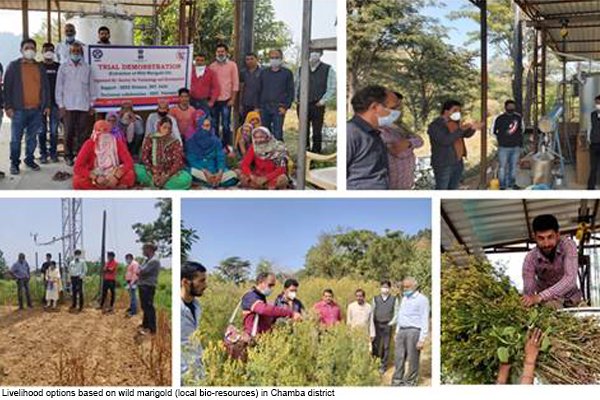New Delhi: Farmers in Chamba district in Himachal Pradesh are looking for new livelihood options to increase their income in addition to traditional crops like maize, paddy and wheat. Cultivation of aromatic plants has provided additional income to the farmers. Farmers have extracted aromatic oils from improved variety of wild marigold (Tagetes minuta) plants and the benefits from wild marigold oil have doubled farmers’ income compared to traditional maize, wheat and paddy crops.

Positive changes have been brought about in the lives and livelihoods of farmers through various measures taken by the Society for Technology and Development (STD), Mandi Core Support Group, Seeds Department and Department of Science and Technology. The Society for Technology and Development in collaboration with CSIR-Himalayan Institute of Biosampled Technology Palampur cultivates aromatic plants (improved varieties of wild marigold, IHBT) and farming community in Parvai village of Bhatiyat block of Chamba, an aspirational district Processing work is started.
A Self Help Group (SHG) of 40 farmers called Green Valley Kisan Sabha Parvai has been formed and has been linked to Himachal Gramin Bank Parachod for financial help. A distillation unit of 250 kg capacity was set up at Parvai village and the farmers were trained in agri-techniques of cultivation of wild marigold, extraction of oil from plants, packing and storage of oil followed by cultivation of wild marigold and oil from it. The evacuation process has been started. The extracted oil is being sold at Rs 9500 per kilogram and is used by pharmaceutical industries in the preparation of perfumes and extracts. Earlier the income of farmers which used to be around 40,000–50,000 rupees per hectare from traditional crops, while now the cultivation of wild marigold and extraction of oil has increased by about Rs.
According to another initiative, farmers have improved pollination by adopting beekeeping techniques of wet soil hives which has also increased the production of apples and increased the income of apple growers by 1.25 times. Himachal Pradesh in technical collaboration with Dr. YS Parmar UHF of Regional Horticultural Research Station (RHRS) Bajaura by Society for Farmers Development under the Time-Learn Program of Seed Division of Department of Science and Technology at Talhar in District Mandi, Himachal Pradesh This technique was introduced for indigenous bees (Apis serena) in Jwalapur village of Balichowki block in Mandi district of the state. In which a total of 45 farmers of the district participated. 80 earthen mounds prepared by trained farmers were planted in apple orchards, covering a total of 20 hectares of land in 6 villages.
Wet hive beekeeping technology is a combination of wall hive and wood hive technology. It has internal provision for placing frames inside the soil hive and for more favorable conditions, especially for adaptation to temperature for bees throughout the year compared to wood leaves.
This technology has been introduced for better colony development and a limited number of bees, making it more profitable than previously used wooden boxed technology. Native bees can survive in apple orchard areas better, with this technology helping to increase the average productivity of apple orchards by about 25 percent compared to Italian bees. Provisions for easy cleaning within the hive have been provided by placing aluminum sheets on its base in the existing soil hive. This sheet is sealed with cow dung and can be removed for cleaning without opening the soil hive. The earthen roof is also made of stone slate, which provides better protection and maintains a favorable temperature inside the hive. This technology has also helped in the extraction of honey in a hygienic manner using honey extracts like wooden boxes and has introduced better management systems, such as food, inspection, clusters and colonies compared to traditional wall hive split of.
A General Public Facilitation Center (CFC) has been set up in the village and the farmers have been trained in the processing and packing of honey. They are also selling 500-600 rupees honey per kg locally.
Science and technology interventions as per the need have helped farmers in an aspiring district of Chamba and agricultural producers in Mandi district of Himachal Pradesh to provide new livelihood options for a better life.
